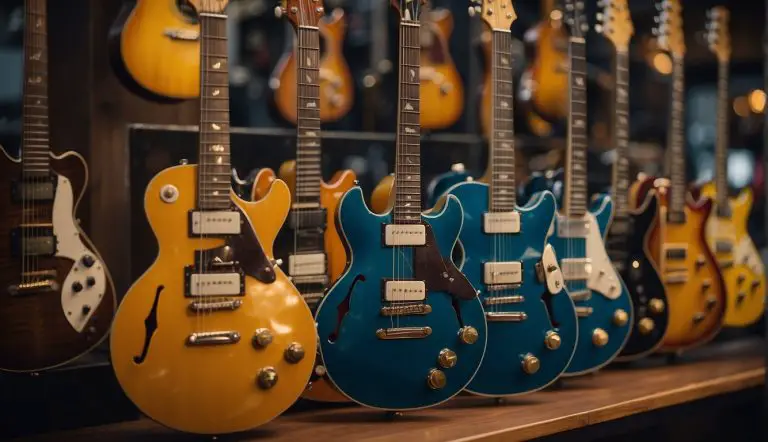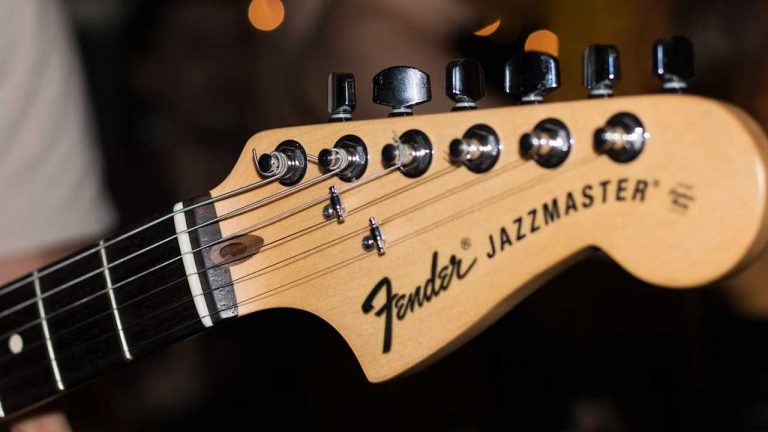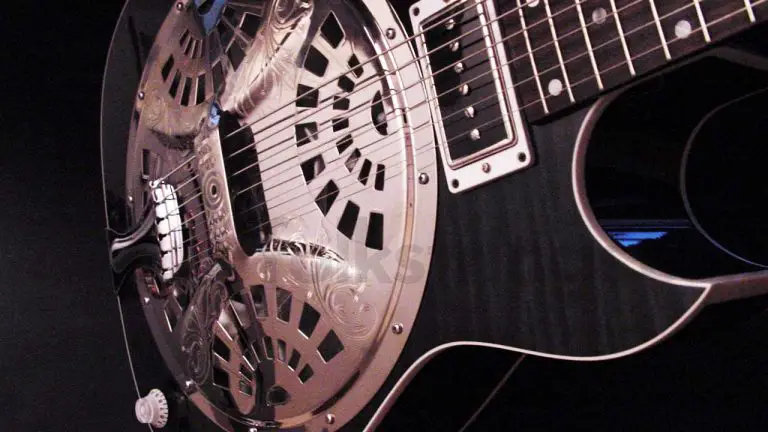What’s The Difference Between an Acoustic and Classical Guitar? – Key Features Explained
Folkstrings.com is reader-supported. When you buy through links on our site, we may earn a small commission.
Acoustic and classical guitars are often mentioned together due to their shared ancestry and similar acoustic properties, yet differences between the two are significant, appealing to various styles and preferences of guitarists.
An acoustic guitar, typically a steel-string guitar, is known for its bright, loud sound which is versatile across many music genres. On the other hand, a classical guitar, using nylon strings, offers a softer, mellower tone favored in classical and flamenco music.
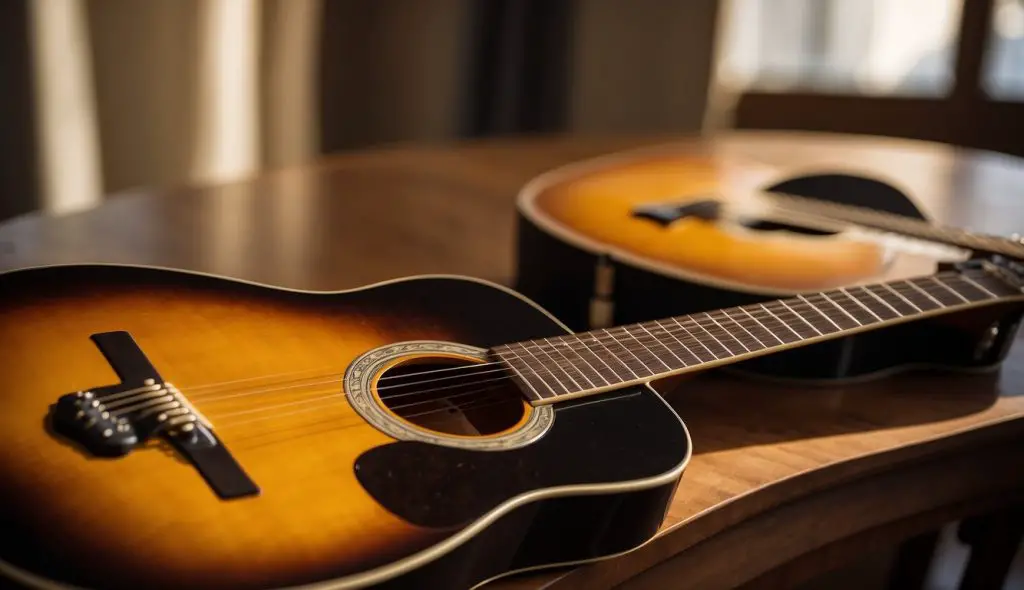
While both types of guitars have a hollow body which amplifies the sound acoustically, the body shape and construction materials contribute to their distinct sound quality.
Classical guitars have a wider neck, which facilitates the intricate finger positioning required for classical pieces. In contrast, the slimmer neck of an acoustic guitar suits fast-paced strumming and a more diverse range of playing styles. Understanding these differences helps in selecting the right type of guitar for one’s musical journey.
Key Points
- Acoustic and classical guitars differ in string type and resulting sound quality.
- The design of a classical guitar’s neck and body caters to specific musical techniques.
- Choice between these guitars depends on the desired music genre and playability.
Table of Contents
Historical Context and Origin
In exploring the rich tapestry of the guitar’s history, I’ll share how the classical and acoustic guitars evolved. Each has a distinct lineage that reflects cultural influences and technological advancements.
Evolution of Classical Guitar
The classical guitar, as we know it today, can trace its roots back to instruments like the vihuela and the Renaissance lute. Around the 19th century, a significant figure in this evolution was Antonio de Torres Jurado. He standardized the design, increasing the body size and altering the proportions, which greatly influenced the instrument’s sound quality and projection.
Before this, what we might recognize as early forms of the classical guitar were smaller and more intimate in terms of sound. These instruments were primarily used for court music and smaller ensemble settings.
The transition into the classical guitar was also marked by changes in playing style and repertoire. My focus on the use of the fingerstyle technique, which involves plucking the strings directly with the fingertips, nails, or a combination of both, became a defining characteristic. This contrasts with the use of a plectrum, or pick, commonly in other guitar styles.
Development of Acoustic Guitar
The term “acoustic guitar” can be somewhat broad, but typically it refers to steel-stringed guitars, which diverged from their classical counterparts in the early 20th century. This is when guitar makers began to experiment with different body shapes and, crucially, the introduction of steel strings, which offer a brighter, louder sound compared to the nylon strings of classical guitars.
Innovation in the structural design of acoustic guitars, such as the adjustable truss rod and X-bracing, allowed them to withstand the increased tension of steel strings. One of the key developments I’ve learned about was the dreadnought body shape, introduced by the Ditson Company and later popularized by C.F. Martin & Company. The dreadnought shape contributed to the powerful and driving sound that became a staple in many American music genres, from folk to bluegrass to rock.
Both classical and acoustic guitars have been favored by different musicians for various genres. The classical guitar remains central to flamenco music, with a slightly different build known as the “flamenco guitar,” characterized by a thinner body and less internal bracing, which allows for a crisper and more percussive sound. Meanwhile, acoustic guitars, with their robust construction and louder volume, became instrumental in more mainstream and popular music contexts.
Design and Construction
In this section, I’ll guide you through the distinct characteristics of acoustic and classical guitars, focusing particularly on their design and body shape, as well as the specifics of neck design and width. Understanding these nuances is essential for any guitarist looking to delve into the details of their instrument.
Body Shape and Size
The body shape of an acoustic guitar is typically larger and comes in various styles, such as dreadnought or jumbo, which contribute to its louder and bolder sound. The design often includes a broader waist and a large soundboard to enhance sound projection.
In contrast, a classical guitar usually has a smaller, more hourglass-like shape, which can yield a softer, more mellow tone. The bracing inside, which supports the top of the guitar, differs as well: classical guitars employ a fan bracing pattern while many acoustic guitars use an X-bracing, affecting resonance and sustain.
| Feature | Classical Guitar | Acoustic Guitar |
|---|---|---|
| Body Shape | Hourglass-like, smaller | Larger, varies by type |
| Soundboard Size | Smaller, sensitive | Larger, robust |
| Bracing | Fan bracing | X-bracing |
Neck Design and Width
My fingers feel the difference most when switching between these two types of guitars.
Classical guitars have a wider neck, which accommodates the traditional fingerstyle playing and nylon strings. The fretboard is flat and the strings are spaced further apart, aiding intricate finger movements.
Acoustic guitars have a narrower neck and usually have a slight radius to the fretboard, which is more accommodating for strumming and bending steel strings. The presence of fret markers on the neck is another notable distinction; they are commonly found on an acoustic’s neck, while typically absent on a classical.
| Feature | Classical Guitar | Acoustic Guitar |
|---|---|---|
| Neck Width | Wider for fingerstyle | Narrower for strumming |
| Fretboard | Flat, no markers | Radiused, with markers |
| String Spacing | Wider for nylon strings | Narrower for steel strings |
Lastly, the types of bridges on these guitars serve the same fundamental purpose but are visually and functionally different. A classical guitar’s bridge is designed to anchor nylon strings with tied ends, while an acoustic guitar’s bridge is built for steel strings with ball ends. This influences the design and construction since each type requires a bridge that can handle the tension and transfer the sound effectively to the body of the guitar.
String Types and Their Impact
In my experience with guitars, I’ve noticed that the type of strings used plays a significant role in both the sound produced and the playability of the instrument. Let’s explore the distinct characteristics of nylon and steel strings and understand their unique features.
Nylon Strings Characteristics
Nylon strings are the hallmark of classical guitars. They produce a warm, mellow tone that’s well-suited for classical and fingerstyle music. I find them to be gentler on the fingers, which makes them a preferred choice for many beginners.
Brands like Ernesto Palla are known for their quality nylon strings. These strings have a lower tension compared to steel strings, which affects the guitar’s tuning stability — meaning I have to retune more frequently.
- Sound Difference: Nylon strings have a softer, more delicate sound.
- Tuning: Lower tension requires more frequent tuning adjustments.
Steel Strings Features
On the other hand, steel strings are synonymous with acoustic guitars and are traditionally used in genres like folk, country, and rock. They tend to produce a brighter, more resonant sound that projects well in both live and studio settings.
While these strings offer greater volume and sustain, they are tougher on the fingertips. Tonewoods, like spruce or mahogany, complement steel strings to enhance their vibrant sound.
Producers like Ernie Ball and their Everlast Coated series bring durability and a variety of tonal options to the mix.
- Sound Difference: Steel strings provide a crispier, louder sound.
- Tonewoods: Different woods can enhance and shape the sound of steel strings.
By understanding these distinctions between nylon and steel strings, I can make more informed decisions about the right strings for my playing style and the music I aim to create.
Playability and Sound
In comparing the playability and sound of acoustic and classical guitars, I consider how the guitar’s design influences its suitability for different playing styles, the tonal qualities produced, and its ability to project sound.
Fingerpicking vs. Strumming
Acoustic guitars, with their steel strings, are typically designed for both fingerpicking and strumming techniques. I find fingerpicking on an acoustic to be quite dynamic, allowing for clear articulation of notes which is essential in genres such as folk and country.
Classical guitars, on the other hand, use nylon strings which are softer and wider spaced. My experience with classical guitars has shown that they are ideal for intricate fingerpicking, producing a gentler and mellow sound favored in classical and Latin music.
Tone and Sound Quality
I’ve noticed the tone of an acoustic guitar is bright and defined, largely due to the steel strings and the body’s construction which often includes a bracing pattern enhancing the resonance of the top wood.
The classical guitar produces a warmer, more mellow sound. This is thanks to the nylon strings and a different bracing design tailored to respond to a lighter touch.
Volume and Projection
Regarding volume and projection, my observation is that acoustic guitars generally have a loud and direct sound, capable of cutting through a mix of other instruments. This is facilitated by their steel strings which can be strummed vigorously.
The classical guitar projects a less intense sound, but one that is rich in harmonics and sustains. Its volume is typically softer, making it well-suited for solo performance or in ensemble settings where nuance is more desired than sheer power.
Applications and Genre
When exploring the worlds of acoustic and classical guitars, it’s essential to understand how they fit into different music genres and which is best suited for beginners. The type of guitar you choose influences the music you’ll create.
Guitars in Different Music Genres
Acoustic and classical guitars feature prominently across various music genres, each with its own distinct sound.
- Classical Music: My classical guitar, with its nylon strings, resonates with a softer, warmer tone that’s perfect for intricate fingerpicking and the gentle nuances of classical pieces.
- Folk Music: Acoustic guitars, especially steel-string ones, shine in folk music thanks to their brighter and louder sound that complements vocal storytelling.
- Country Music: In country music, I find the resonant twang of an acoustic guitar fits just right with the genre’s heartfelt lyrics and melodies.
- Latin: The nylon strings of classical guitars bring authentic sounds to Latin genres with their clear, crisp tones ideal for fast rhythms.
- Jazz: My choice often leans towards an acoustic guitar for jazz, as its rich tones and versatility allow for complex chords and smooth transitions.
- Rock/Pop Music: While not as common as electric guitars, acoustic guitars hold their own in rock and pop music, providing a rhythmic foundation or a contrasting acoustic section in a song.
Recommended Guitars for Beginners
Choosing the right guitar as a beginner can shape your entire musical journey. I’ll help you understand which might be more suitable:
- Classical Guitar: I’d recommend a classical guitar to beginners who are interested in classical or Latin genres. Its wider fretboard allows for easier finger placement when learning chords.
- Acoustic Guitar: For beginners keen on diving into rock, pop, country, or folk music, an acoustic guitar is generally my recommendation. Its versatility and the prevalence of these genres make it a great starting point.
Selecting between acoustic and classical guitars boils down to personal preference and the musical path you’re excited to embark on.
Maintenance and Accessories
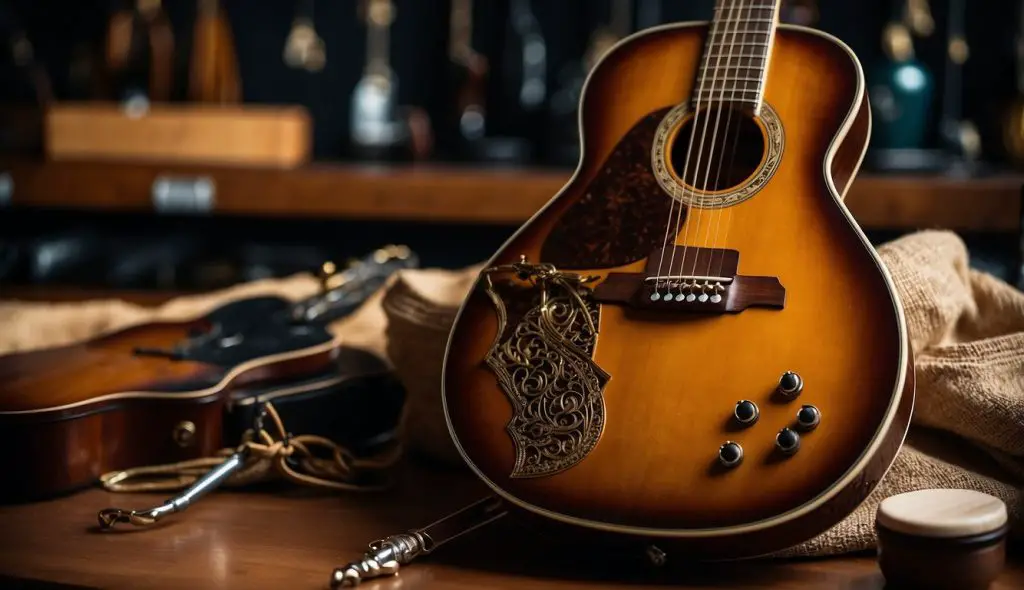
When it comes to maintaining my guitar, I focus on preserving its sound quality and playability. Accessories are pivotal in enhancing my playing experience.
Proper Care for Guitars
My acoustic and classical guitars both need regular maintenance to perform their best. The truss rod, a crucial part of the guitar neck, may require adjustments to maintain proper neck relief and action. I make sure to check it every few months or when I notice changes in string action, ensuring my guitars maintain their playability.
For the guitar nut, the first point of contact for the strings, I keep it clean and occasionally lubricated, which prevents string wear and helps with tuning stability.
On the classical guitar, which uses nylon strings, there is less tension on the nut, so it is less prone to wear but still requires attention to avoid any string buzz.
Cleaning is another important aspect. I regularly wipe down the body and strings of my acoustic guitar to prevent dirt build-up that can affect the sound. The classical guitar, especially the one with a satin or French polish finish, needs a bit more care as it can easily pick up fingerprints and smudges.
Essential Guitar Accessories
I have found that having a few key accessories can make a big difference in my playing. Here’s a brief list of essentials:
- Capo: A capo is a device I use on the guitar’s neck to transpose or change the pitch of open strings. Acoustic guitars can use a variety of capo styles, while classical guitars need capos designed to match their wider, flatter fretboards.
- Plectrum (Pick): Whereas I use a plectrum to strike the strings on my acoustic guitar for a brighter sound and more attack, it’s less commonly used with classical guitars, which are typically played with the fingers for a softer tone.
- Pickguard: My acoustic guitar has a pickguard to protect its finish from getting scratched by a pick. Classical guitars usually don’t have a pickguard, as they’re intended for fingerstyle playing.
- Humidifier: To prevent wood damage due to dry conditions, I use a humidifier, especially important for the maintenance of my acoustic guitar.
Here’s a simplified table summarizing the pros and cons of each accessory:
| Accessory | Pros | Cons |
|---|---|---|
| Capo | Transpose music quickly | Can affect intonation if not used properly |
| Plectrum | Brighter sound, more attack | Can scratch the guitar without a pickguard |
| Pickguard | Protects finish | Aesthetic change that might not be desired |
| Humidifier | Prevents wood cracks | Needs regular monitoring and refilling |
In my continued research, I focus on finding the best ways to care for and accessorize my guitars. It’s a practical endeavor that helps keep my instruments sounding great for years.
Frequently Asked Questions
In this section, I’ll address some common inquiries regarding the differences between acoustic and classical guitars.
What distinguishes the fretboard of a classical guitar from that of an acoustic guitar?
The fretboard of a classical guitar is typically wider and has a flat profile, which gives more space between strings, aiding fingerstyle playing.
In contrast, acoustic guitars usually have a narrower and slightly curved fretboard that suits strumming and fingerpicking techniques.
Is there a difference in sound between classical and acoustic guitars?
Yes, classical guitars produce a softer, mellower tone due to their nylon strings, whereas acoustic guitars, which use steel strings, have a brighter and more resonant sound that projects with more volume.
Can classical guitar techniques be applied to an acoustic guitar?
Many classical guitar techniques can be applied to an acoustic guitar; however, the steel strings of an acoustic guitar can be harder on the fingers, and the narrower neck may affect finger placement for certain classical techniques.
For beginners, which type of guitar is generally recommended to start with?
For beginners, classical guitars are often recommended because their nylon strings are easier on the fingers, and the wider fretboard allows for easier chord formation when learning.
What are the physical differences between acoustic and Spanish guitars?
Acoustic guitars typically feature a robust construction to withstand the tension of steel strings, have a narrow neck, and sometimes include a pickguard.
Spanish guitars, or classical guitars, have nylon strings, wider necks for fingerstyle play, and lack a pickguard since they’re primarily played with fingers instead of picks.
In terms of learning curve, how does playing a classical guitar compare with an acoustic guitar?
Playing a classical guitar may have a gentler learning curve for beginners due to the ease of pressing down on nylon strings and forming chords on the wider neck.
In contrast, an acoustic guitar’s steel strings may require more finger strength and dexterity initially.
Author Profile
-
Daniel Johnstone is an English writer with a love for stringed instruments from around the world.
He shares his love for these instruments through his writing for folkstrings.com, a website dedicated to all things related to folk string music.
Daniel's passion for music started at a young age, and he has since become an accomplished musician, playing guitar, cavaco, and recently, the harp.
His dedication to learning and sharing his knowledge of stringed instruments is evident in his insightful and engaging blog posts. Whether you're a seasoned musician or a beginner, Daniel's writing is sure to inspire and entertain you.
When he's not playing music or writing, you can find Daniel exploring new instruments and seeking out new sounds to share with his readers.
Latest entries
 OcarinaApril 1, 2024Why Does My Ocarina Sound Bad? Tips for Improved Tone Quality
OcarinaApril 1, 2024Why Does My Ocarina Sound Bad? Tips for Improved Tone Quality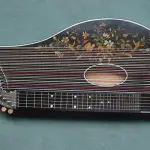 ZitherMarch 30, 2024Who Are Some Famous Zither Instrument Players? Let’s Find Out!
ZitherMarch 30, 2024Who Are Some Famous Zither Instrument Players? Let’s Find Out! ZitherMarch 30, 2024Should I Learn the Zither? Exploring the Benefits of This Unique Instrument
ZitherMarch 30, 2024Should I Learn the Zither? Exploring the Benefits of This Unique Instrument ZitherMarch 30, 2024What is the History of the Zither: Tracing the Strings Through Time
ZitherMarch 30, 2024What is the History of the Zither: Tracing the Strings Through Time
Affiliates:
This post may contain affiliate links that at no additional cost to you, the site may earn a small commission. We only recommend products we would use ourselves and all opinions expressed on this site are our own.
Accuracy Advice:
While we strive to provide up-to-date and accurate information, the content in this article may not reflect the most current research or medical guidelines. We encourage readers to do further research and consult with professionals for more personalized advice.
Our Recommendations:
The products and services mentioned in any of our articles are recommended based on our independent research and personal experience. We are not sponsored by any company. We aim to suggest products and services we believe are of high quality and could be beneficial to our readers.


